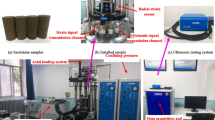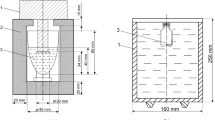Abstract
Special requirements for design of tools used for wireline NMR logging and NMR logging while drilling and for interpretation model are demanded due to the dispersion properties of NMR relaxation for crude oil. NMR longitudinal relaxation time (T 1) and transverse relaxation time (T 2) of the dead oil samples with different viscosities were measured by NMR spectrometers with a Larmor frequency of 2 MHz and 23 MHz at five different temperatures respectively. The results showed thatT 1 was obviously dependent on the Larmor frequency of NMR spectrometer. The degree ofT 1 dispersion became stronger with the increasing crude oil viscosity, Larmor frequency and the viscosity/temperature ratio.T 2 was independent of NMR spectrometer measuring frequency. It is suggested that the resonance frequency should be selected lower than 2 MHz when measuringT 1 in logging while-drilling and thatT 1 dispersion should be corrected when Larmor frequency is higher than 2 MHz.
Similar content being viewed by others
References
Coates G. R., Xiao L. Z. and Prammer M. G. (1999)NMR Logging Principles and Applications. Houston: Gulf Publishing Company
Cowan B. (1997)Nuclear Magnetic Resonance and Relaxation. New York: Cambridge University Press
Dunn K. J., Bergman D. J. and Latorraca G. A. (2002)Nuclear Magnetic Resonance: Petrophysical and Logging Applications. Pergamon: Elsevier Science
Freedman R., Lo S. W., Flaum M., Hirasaki G. J., Matteson A. and Sezginer A. (2001) A new NMR method of fluid characterization in reservoir rocks: Experimental confirmation and simulation results.SPE Journal, 6, 452–464
Hirasaki G. J., Lo S. W. and Zhang Y. (2003) NMR properties of petroleum reservoir fluids.Magnetic Resonance Imaging, 21, 269–277
Kleinberg R. L. and Vinegar H. J. (1996) Nuclear properties of reservoir fluids.The Log Analyst, 37, 20–32
Lo S. W., Hirasaki G. J. and House W. V. (2000) Mixing rules and correlations of NMR relaxation time with viscosity, diffusivity, and gas/oil ratio of methane/hydrocarbon mixtures.SPE 63217
McConnell J. (1980)Rotational Brownian Motion and Dielectric Theory. New York: Academic Press
McConnell J. (1987)The Theory of Nuclear Magnetic relaxation In Liquids. New York: Cambridge University Press
Morriss C. E., Freedman R., Straley C, Johnston M., Vinegar H. J. and Tutunjian P. N. (1997) Hydrocarbon saturation and viscosity estimation from NMR logging in the Belridge Diatomite.The Log Analyst, 38 (2), 44–59
Xiao L. Z. (1998)Magnetic Resonance Imaging Logging and Rock’s Magnetic Resonance and Its Application. Beijing: Science Press (in Chinese)
Zhang Y., Hirasaki G. J., House W. V. and Kobayashi R. (2002) Oil and gas NMR properties: The light and heavy ends.SPWLA 43rd Annual Logging Symposium, paper: HHH, 1–13
Author information
Authors and Affiliations
Additional information
Xie Ranhong was born in 1966 and received her MS degree from China University of Petroleum in 1992. Now she is an associate professor at the China University of Petroleum (Beijing), and engaged in NMR well logging applications. E-mail: xieranhong@cup.edu.cn
Rights and permissions
About this article
Cite this article
Ranhong, X., Lizhi, X. Dispersion properties of NMR relaxation for crude oil. Pet. Sci. 4, 35–38 (2007). https://doi.org/10.1007/BF03187439
Received:
Issue Date:
DOI: https://doi.org/10.1007/BF03187439




